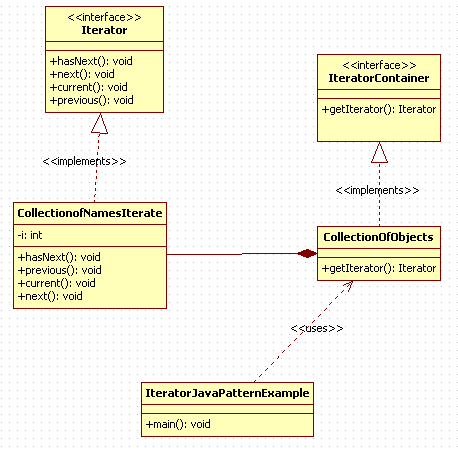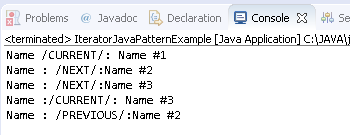#
Iterator
This tutorial explains to you the design pattern named Iterator (which is a Structural Pattern).
#
Iterator Pattern - theory
Iterator Design Pattern in Java is used when we want to provide a way to access a collection of objects sequentially
without exposing its underling implementation. Iteration pattern is also known as Cursor.
Take a look at the following UML diagram representing the Iterator design pattern (for my example):

In this example you can see that you can traverse the list of objects in both senses. The iteration of the collection is done inside the collection class.
#
Iterator Pattern - example
Here is an example of using the Iterator Design Pattern in Java:
package iterator.java.pattern.example;
public interface Iterator {
public boolean hasNext();
public Object next();
public Object current();
public Object previous();
}
package iterator.java.pattern.example;
public interface IteratorContainer {
public Iterator getIterator();
}package iterator.java.pattern.example;
public class CollectionOfObjects implements IteratorContainer {
public String name[]={"Name #1", "Name #2","Name #3","Name #4"};
@Override
public Iterator getIterator() {
return new CollectionofNamesIterate() ;
}
private class CollectionofNamesIterate implements Iterator{
private int i = 0;
@Override
public boolean hasNext() {
if (i < name.length ){
return true;
}
return false;
}
@Override
public Object previous() {
if(i > 1){
i = i-1;
return name[i];
} else {
i = 0;
return null;
}
}
@Override
public Object current() {
return name[i];
}
@Override
public Object next() {
if(this.hasNext()){
i = i + 1;
return name[i];
} else {
return null;
}
}
}
}package iterator.java.pattern.example;
public class IteratorJavaPatternExample {
public static void main(String[] args) {
String name = null;
CollectionOfObjects cmpnyRepository = new CollectionOfObjects();
Iterator iter = cmpnyRepository.getIterator();
System.out.println("Name /CURRENT/: " + (String)iter.current());
System.out.println("Name : /NEXT/:" + (String)iter.next());
System.out.println("Name : /NEXT/:" + (String)iter.next());
System.out.println("Name :/CURRENT/: " + (String)iter.current());
System.out.println("Name : /PREVIOUS/:" + (String)iter.previous());
}
}Info
This design pater is provided out of the boxy by Java, using Iterable interface (so we can use Iterator, ListIterator interfaces later).
When you run this example you will receive the following result:


